John Pickup: I love a sunburnt country...Of drought and flooding rains
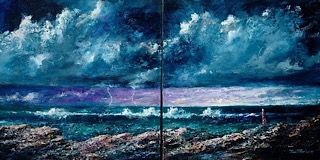
Remembrance of rivers and creeks and fascination with the way the ocean moves has been a feature of the oeuvre of John Pickup. I’m not sure if this is surprising or unsurprising given that John lived for more than half his life in Broken Hill (New South Wales) - on the edge of desert country. He also spent some time in Darwin, the inspiration to the painting above: Build up to the Wet. Finally he retired to Queensland where water is more than plentiful; where the rivers run deep and strong: matching John’s passion for creative output.
I have spent a wonderful couple of weeks discussing painting with John Pickup and for me his spirit and painting style is like an Australian river with swirling contrasting colours, fast rapids and quiet pools and the tips of the waves lit up with the sunlight of life. The Gorge is one of John’s own favourite paintings and exemplifies his mastery of creating images of water in its many personifications. John paints solely in oils and has a penchant for a palette knife.
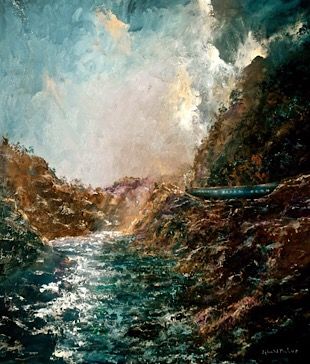
Notice how John creates a strong contrast between the sunlit white tops of the waves on the left to the dark viridian green in the shadow of the mountain on the right. Notice also that the train is almost the same tone as the water so as not to dominate the image, leaving the raging water as the point of interest. Of course, the clouds above are magnificent and echo the tumultuous water below. A perfect painting.
Here in Australia we either have too much water or not enough. As the great Australian poet Dorothea Mackellar expressed in My Country: I love a sunburnt country...Of drought and flooding rains. John Pickup has brought through his vibrant oil paintings so many interpretations of these poetic lines.
Waterlilies (below) however is based on a poem written by another great Australian Henry Lawson. As John explains: the poem and painting illustrate a grieving mother standing near the place where her child drowned while trying to walk on the waterlilies.A sad little story. And the water is dark and still beneath the spirit of the child; the waterlilies bright and enticing. If you look carefully into the painting you will see a small waterfall entering the water on the left perhaps symbolising a connection back to the mortal world.
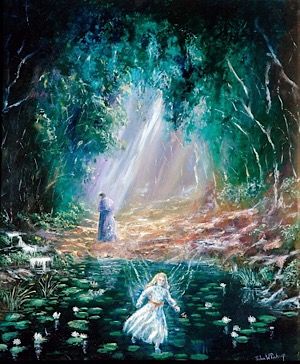
Beach Dreaming was inspired by a friend of John's relating that she had a dream in which she was lying in a bath on a beach. For me this painting illustrates so well John Pickup's mastery of the use of colour. Not tempted at all to paint the bath white ( as would most of us), John has reflected the sand and distant ocean and the vibrant sky in the colours of the bath and bath water. This brings about a harmony between the woman in the bath and the surrounding environment: sand, sea, sky. The woman doesn't stand out as a focus subject but rather blends into become a natural object on the seashore. She is quite at home in this position. The contrast between the green of the sea in the middle ground with the deep near ultramarine blue of the far ocean, reflecting the blue of the sky, adds interest and beckons the woman's dreaming beyond the beach to the horizon and beyond. This painting passes our test that art must have congruence as we were discussing a little while ago.
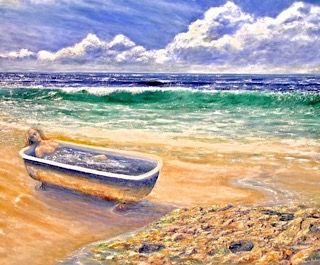
John did remark about Beach Dreaming (above) that he is fascinated with the way the ocean moves and that he was happy that he had captured the surf reasonably well. No photos were used- just memories.
And the winner is: Broken River Dive. I just love this painting in which John has given the water centre stage. This way he can showcase the tones, the lights and shadows, the topographical features that are found beneath the water. What does John Pickup want to achieve? He wants you the viewer to see what the diver sees: the glory beneath the surface.
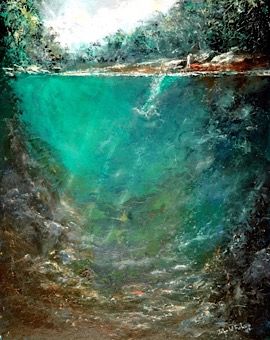
Let's dissect the painting a little so we can learn how John has created such a beautiful image. First he has a very high horizon so that the eye line of the viewer is directly at the same level as the diver: the viewer is diving beneath the water also. The canyon like composition (like an upsidedown V) forces you to focus on the centre of the painting at first, later letting your eyes wander to take in the details of the sides which act like a frame. This is important in a painting. For me, all paintings should tell a story and all composition should lead the viewer on a journey around the image. The subtle sunlight penetrating deep into the river is beautiful and aids John in lightening up the top left of the river which can then act as a contrast to the darkening shadows on the right. The diver and bubbles not only give the image a narrative but also remind us that this isn't imaginary: humans can experience the same glory of being underwater as do water creatures. There is so much going on in this painting that I could spend a long time studying the details of the rocky underwater outcrops with their craggy edges contrasting with the soft the water plants. The land above the river offers context to the location and is in total tonal harmony with the water below.
Tomorrow we will look at a few more of John's paintings that feature water but with far more drama.

